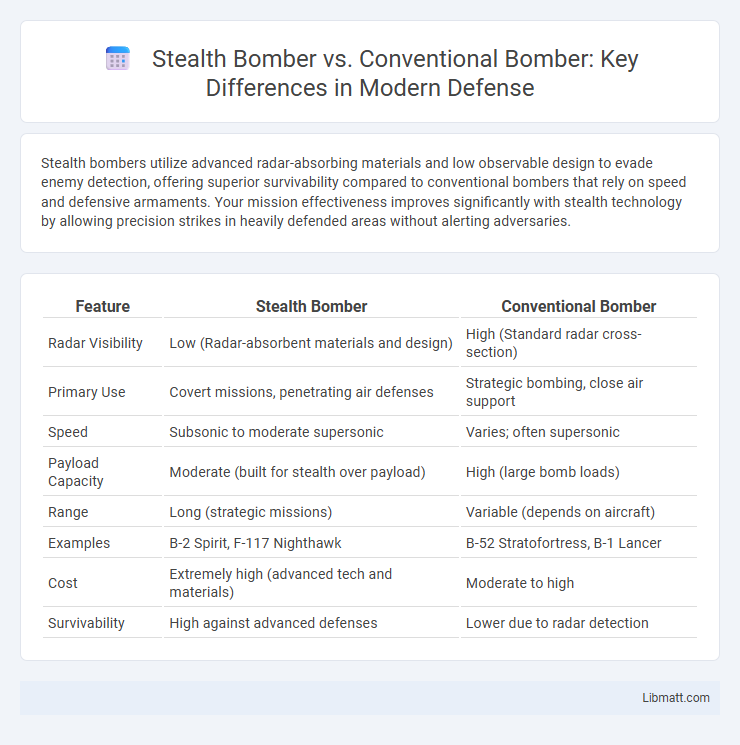Stealth bombers utilize advanced radar-absorbing materials and low observable design to evade enemy detection, offering superior survivability compared to conventional bombers that rely on speed and defensive armaments. Your mission effectiveness improves significantly with stealth technology by allowing precision strikes in heavily defended areas without alerting adversaries.
Table of Comparison
| Feature | Stealth Bomber | Conventional Bomber |
|---|---|---|
| Radar Visibility | Low (Radar-absorbent materials and design) | High (Standard radar cross-section) |
| Primary Use | Covert missions, penetrating air defenses | Strategic bombing, close air support |
| Speed | Subsonic to moderate supersonic | Varies; often supersonic |
| Payload Capacity | Moderate (built for stealth over payload) | High (large bomb loads) |
| Range | Long (strategic missions) | Variable (depends on aircraft) |
| Examples | B-2 Spirit, F-117 Nighthawk | B-52 Stratofortress, B-1 Lancer |
| Cost | Extremely high (advanced tech and materials) | Moderate to high |
| Survivability | High against advanced defenses | Lower due to radar detection |
Introduction: Stealth vs. Conventional Bombers
Stealth bombers utilize advanced radar-absorbing materials and designs to minimize detection, enabling highly covert missions compared to conventional bombers that rely on speed and altitude for defense. Your ability to penetrate heavily defended airspace is significantly enhanced with stealth technology, reducing the risk of interception and increasing mission success rates. Conventional bombers remain valuable for large payload capacities and versatility but are more vulnerable to modern radar and missile systems.
Historical Evolution of Bomber Aircraft
The historical evolution of bomber aircraft reveals a transition from conventional bombers, which relied on speed and altitude to evade enemy defenses, to stealth bombers designed to minimize radar detection using advanced materials and shapes. Early models like the B-17 Flying Fortress emphasized payload and range, while later developments such as the B-2 Spirit introduced stealth technology to penetrate sophisticated air defenses undetected. Your understanding of this evolution highlights how military strategy shifted towards enhancing survivability and mission effectiveness through technological innovation.
Key Design Differences: Stealth and Conventional Bombers
Stealth bombers feature radar-absorbent materials and angular designs to minimize radar cross-section, enabling evasion of enemy detection systems; conventional bombers rely on larger, more aerodynamic structures optimized for payload capacity and range. Stealth technology incorporates advanced composites and heat-reducing engine placements to reduce infrared signatures, whereas conventional bombers prioritize fuel efficiency and payload versatility without emphasis on low observability. Key differences also include cockpit design, with stealth bombers often using enclosed, low-profile configurations that support stealth objectives, contrasting with the more traditional cockpits of conventional bombers designed for broader operational roles.
Radar Evasion Capabilities
Stealth bombers utilize advanced radar-absorbent materials and angular designs to minimize radar cross-section, enabling them to evade detection by enemy radar systems more effectively than conventional bombers. Unlike traditional bombers, which rely on speed and altitude for defense, stealth bombers can penetrate heavily guarded airspace undetected, significantly increasing mission success rates. Their radar evasion capabilities reduce the likelihood of interception, making them essential for modern strategic bombing operations.
Payload and Weapons Systems Comparison
Stealth bombers like the B-2 Spirit feature advanced payload flexibility, carrying up to 40,000 pounds of precision-guided munitions, including JDAMs and nuclear weapons, within internal bays to maintain low radar visibility. Conventional bombers such as the B-52 Stratofortress have a larger total payload capacity, exceeding 70,000 pounds, but rely more heavily on external hardpoints for weapon carriage, increasing their radar signature. The stealth design prioritizes covert strike capabilities with integrated electronic warfare systems, while conventional bombers emphasize payload volume and diverse ordnance options.
Mission Profiles and Strategic Roles
Stealth bombers excel in high-risk, penetrating missions against heavily defended targets by utilizing low radar cross-section technology to evade enemy detection, enabling precise strikes within contested airspace. Conventional bombers are suited for a broader range of strategic roles, including large-scale bombing campaigns and long-duration patrols, benefiting from greater payload capacity and operational versatility. The mission profiles of stealth bombers prioritize covert attacks and network-centric warfare, while conventional bombers focus on sustained firepower and support in less contested environments.
Survivability in Modern Warfare
Stealth bombers like the B-2 Spirit use advanced radar-absorbent materials and design features to minimize radar cross-section, significantly enhancing survivability against modern air defense systems compared to conventional bombers such as the B-52 Stratofortress. Their ability to evade detection allows stealth bombers to penetrate heavily defended areas and conduct precision strikes with reduced risk of interception or missile engagement. Conventional bombers rely more on electronic countermeasures and escort fighters for survivability, making them more vulnerable to advanced integrated air defense networks in contemporary combat scenarios.
Cost and Maintenance Considerations
Stealth bombers, such as the B-2 Spirit, incur significantly higher acquisition costs compared to conventional bombers due to advanced materials and stealth technology integration. Maintenance demands for stealth aircraft are extensive, requiring specialized facilities and procedures to preserve radar-absorbent coatings, driving up lifecycle expenses. Conventional bombers benefit from more established maintenance protocols and lower operational costs, though they lack the survivability advantages of stealth designs.
Technological Advancements and Innovations
Stealth bombers incorporate advanced technologies such as radar-absorbent materials, angular design, and electronic countermeasures that significantly reduce radar cross-section and detection probability compared to conventional bombers. Innovations like low observable coatings and internal weapon bays enhance the stealth bomber's ability to penetrate heavily defended airspace undetected, ensuring mission success with greater precision. Your strategic capabilities improve dramatically with these cutting-edge technological advancements, enabling covert operations that conventional bombers cannot achieve.
Future Prospects in Aerial Warfare
Stealth bombers offer a strategic advantage in future aerial warfare by minimizing radar detection, allowing You to conduct precision strikes with reduced risk of interception. Conventional bombers, while capable of carrying heavier payloads, face increasing vulnerability due to advancements in enemy radar and missile systems. The evolving threat landscape prioritizes stealth technology for maximizing mission success and survivability in contested airspace.
stealth bomber vs conventional bomber Infographic

 libmatt.com
libmatt.com